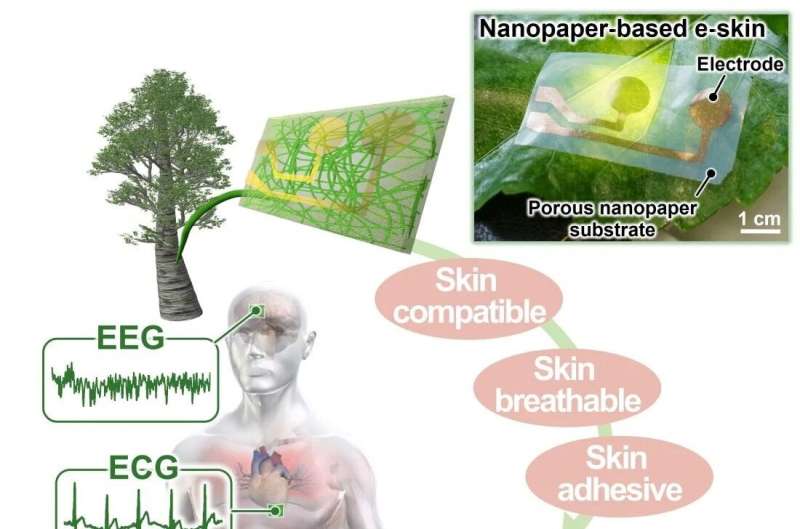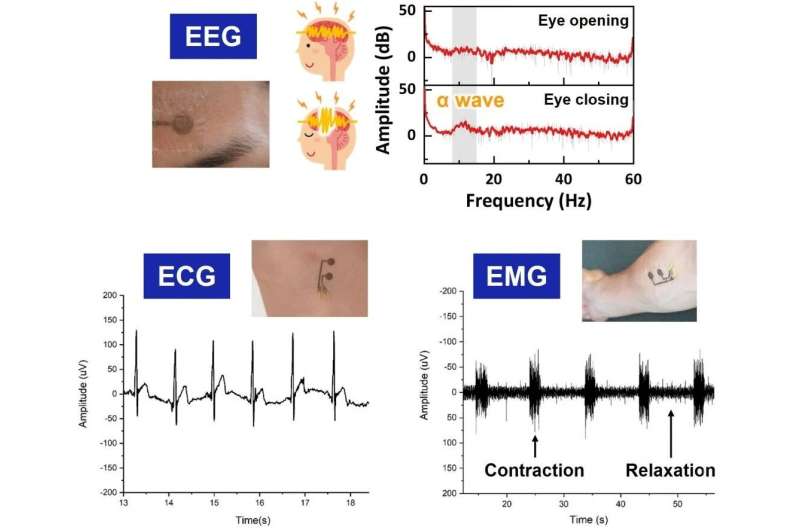This article has been reviewed according to Science X's editorial process and policies. Editors have highlighted the following attributes while ensuring the content's credibility:
fact-checked
peer-reviewed publication
trusted source
proofread
Researchers design a cellulose nanofiber paper that can be used as a substrate for on-skin electronics

The idea of wirelessly gathering electrical information from the body through the skin is not new. However, the ideal electrode material must fulfill a significant list of criteria to be a realistic candidate for use on patients. Researchers from Osaka University have designed an electrode substrate derived from wood that appears to tick all the boxes. Their findings have recently been published in Advanced Materials Interfaces.
The electrodes needed for on-skin electronics are supported by a substrate material that makes effective contact with the skin. Choosing a substrate requires the consideration of numerous factors: Is it flexible and comfortable to wear, but still durable? Can the substrate be sterilized so that it can be reused? Does it stick well to the skin and allow the skin to breathe? Is the substrate environmentally sustainable to produce and dispose of?
Finding a candidate is therefore tricky, but the Osaka researchers believe they have designed the most promising one to date. Their cellulose-based material is essentially paper made up of tiny nanofibers, giving it the name "nanopaper e-skin," and it is the gaps between the fibers, whose size can be controlled, that give their substrate the edge.
"To get the best possible electrical signal it is important for a substrate to make good contact with the skin, which means it must be smooth. However, many examples of smooth materials are also very dense which severely reduces their breathability and results in user discomfort," says study author Teppei Araki. "Because our nanopaper is a mesh of very fine fibers, it maintains good contact with the skin, but also has pores meaning that water vapor can pass through, reducing inflammation and making it comfortable to wear," explains study first author Yintong Huang.

Once wet, the nanopaper could stick to skin because of the action of the water in the pores, and it was able to withstand 100 cycles of deformation on the forehead while maintaining function. The nanopaper could also be sterilized at high temperature.
"We believe that our nanopaper offers compatibility with both the body and the environment," says senior author Hirotaka Koga. "The availability, flexibility, skin-conformability and -breathability, thermal stability, toughness, biocompatibility, and environmental sustainability of our substrate all combine to make it a highly promising candidate for electrophysiological monitoring that we expect to easily translate into the clinic for the measurement of data such as ECGs."
These results provide a very promising step forward in the field of on-skin electronics and may be the jump needed for explosive developments when researchers combine techniques of flexible and sustainable electronics that they have developed.
More information: Yintong Huang et al, Skin‐Adhesive, ‐Breathable, and ‐Compatible Nanopaper Electronics for Harmonious On‐Skin Electrophysiological Monitoring, Advanced Materials Interfaces (2023). DOI: 10.1002/admi.202202263
Ashuya Takemoto et al, Fully Transparent, Ultrathin Flexible Organic Electrochemical Transistors with Additive Integration for Bioelectronic Applications, Advanced Science (2022). DOI: 10.1002/advs.202204746
Rei Kawabata et al, Stretchable printed circuit board integrated with Ag-nanowire-based electrodes and organic transistors toward imperceptible electrophysiological sensing, Flexible and Printed Electronics (2022). DOI: 10.1088/2058-8585/ac968c
Hirotaka Koga et al, Nanocellulose Paper Semiconductor with a 3D Network Structure and Its Nano–Micro–Macro Trans-Scale Design, ACS Nano (2022). DOI: 10.1021/acsnano.1c10728
Luting Zhu et al, All-cellulose-derived humidity sensor prepared via direct laser writing of conductive and moisture-stable electrodes on TEMPO-oxidized cellulose paper, Journal of Materials Chemistry C (2022). DOI: 10.1039/D1TC05339F
Journal information: Advanced Science , ACS Nano
Provided by Osaka University





















